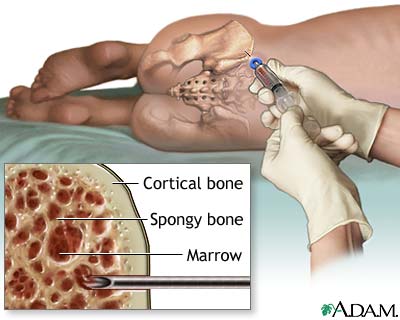Treatment
The goal of treatment is to get the blood counts and the bone marrow back to normal. If this occurs and the bone marrow looks healthy under the microscope, the cancer is said to be in remission.

If you have ALL, you will need chemotherapy. For the first round of chemotherapy (called induction), you may need to stay in the hospital for 3 – 6 weeks.
Later you may get chemotherapy on an outpatient basis (living at home and going to a clinic to receive your treatments). If you have a low white blood cell count, you may need to be placed in a room by yourself so you do not catch an infection.
Many chemotherapy drugs given into the veins do not reach the brain and spinal cord tissue. Therefore, many patients will also receive radiation therapy to the brain or chemotherapy drugs injected into the space around the brain and spinal column to prevent later spread to these sites.
If you go into remission, you may receive additional chemotherapy or radiation therapy to kill any cancer cells that are in the spinal fluid. You may also receive chemotherapy from time to time to prevent relapse. A bone marrow or stem cell transplant may also be recommended, especially if one of your siblings is proven to be a full match.
If your leukemia returns or does not respond to other treatments, a bone marrow or stem cell transplant is usually recommended.
Additional treatments depend on other symptoms. They may include:
* Transfusion of blood products, such as platelets or red blood cells, to fight thrombocytopenia and anemia
* Antibiotics to fight infection, especially if a fever occurs
Support Groups
Patients can ease the stress of their illness by joining a support group where members share common experiences and problems.
See also: Cancer – support group
Prognosis (Expectations)
Children usually have a better outcome than adults. Almost all children go into complete remission. Without treatment, a person with ALL can expect to live for only about 3 months.
The following patients tend to do better:
* Younger adults (especially those younger than age 50)
* Children between the ages of 1 and 9
* Those who have a WBC count below 50,000 when first diagnosed
* Those who do not have a Philadelphia chromosome-positive ALL (a specific genetic change)
* Those who achieve complete remission (disappearance of signs and symptoms of cancer) within 4 – 5 weeks of starting treatment
Patients whose leukemia spreads to the brain or spinal cord tend to have a worse outcome.
Complications
* Bleeding
* Damage to different organs from chemotherapy
* Disseminated intravascular coagulation (DIC)
* Relapse of ALL
* Severe infection
* Spread of the cancer to other parts of the body
Calling Your Health Care Provider
Call your health care provider if:
* You develop ALL-like symptoms
* You have ALL and you have a persistent fever or other signs of infection
Acute lymphocytic leukemia (ALL): Overview, Causes
Acute lymphocytic leukemia (ALL): Symptoms & Signs, Diagnosis & Tests
Acute lymphocytic leukemia (ALL) : Treatment
Reviewed By : David Zieve, MD, MHA, Medical Director, A.D.A.M., Inc., and Yi-Bin Chen, MD, Leukemia/Bone Marrow Transplant Program, Massachusetts General Hospital.
